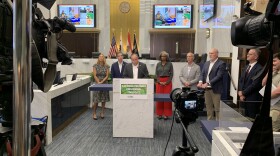STEVE INSKEEP, host:
It's MORNING EDITION from NPR News. Renee Montagne is in Afghanistan. I'm Steve Inskeep. Good morning.
The National Transportation Safety Board is trying to determine what caused a small plane to crash in Manhattan yesterday. It struck a high-rise apartment building on the Upper East Side. The crash killed Cory Lidle, a pitcher for the New York Yankees, and another person who is believed to be Lidle's flight instructor. And this incident bore some painful similarities to the September 11th attacks.
NPR's Jim Zarroli reports.
JIM ZARROLI: Small planes fly over Manhattan all the time, and this one attracted little notice at first. The plane took off from Teterboro Airport in New Jersey at about 2:30, circled the Statue of Liberty, and then headed up the East River. Mayor Mike Bloomberg says around the 59th Street Bridge, it suddenly disappeared off radar screens.
Mayor MIKE BLOOMBERG (New York City): If the plane had started to descend, that's exactly what you would expect. Radar coverage only goes so low, and after that there is no radar track of how it got onto 72nd Street.
ZARROLI: Working in a building on the Upper East Side, Anthony Francovilla(ph) heard a small plane approach, its engine straining.
Mr. ANTHONY FRANCOVILLA (Worker): A normal plane would be consecutive. This was, like, three spurts. Like, vroom, vroom, vroom, and then boom. And that was the end of it, right into the side of the building.
ZARROLI: Francovilla saw the plane hit a building called the Belaire, one of the many modern apartment buildings on the East River. Two people in an apartment on the 40th floor of the building, watched as pieces of the aircraft suddenly flew through their windows. They escaped unhurt.
At quarter to three, the first calls came in to 911. News of the crash spread quickly and many people had the same thought as Admiral Timothy Keating, Chairman of the U.S. Northern Command, or NORAD.
Admiral TIMOTHY KEATING (Chairman, U.S. Northern Command): My first reaction, when I saw an airplane in a building in New York City, was: oh no, let's get busy.
ZARROLI: Keating says almost instantly fighter jets were launched from bases in Canada and the United States, and within 10 minutes they were airborne over New York and Washington. They would stay in the air for hours, even though intelligence agencies concluded quickly, that the crash was probably not terrorism-related.
Meanwhile, hundreds of police, firefighters, and EMTs were arriving in the quiet, Upper East Side neighborhood where the crash occurred.
Again, Mayor Bloomberg.
Mayor BLOOMBERG: Massive and quick and coordinated, I think, is a good way to phrase it. Everybody was able to get their equipment through traffic here. Response time was very fast.
ZARROLI: As crowds watched behind police emergency tape, the fire was extinguished and the building evacuated. Mayor Bloomberg conceded that the challenge faced by police and firefighters turned out to be so much smaller than 9/11. But, he said, New Yorkers can still take comfort from the way the crash was handled and the way police and firefighters have learned to work together in recent years.
Mayor BLOOMBERG: The Office of Emergency Management has run drill after drill after drill and has sat with both to make sure that when we have to work together, we know what each person's and each agency's responsibility is. And they did exactly what they were supposed to do.
ZARROLI: Likewise, Admiral Keating said the quick response by NORAD yesterday should reassure people about how seriously the military takes terrorism threats since 9/11.
Adm. KEATING: We're much more alert, much more ready and much more capable of providing air patrols over the United States and Canada.
ZARROLI: Even before the fire was put out, the National Transportation Safety Board sent a team to New York to begin investigating the crash. Former NTSB Chief Investigator Ben Berman said in a major plane crash investigators first comb the wreckage to try to find the cockpit voice recorder and flight data recorder.
Mr. BEN BERMAN (Former Chief Investigator, National Transportation Safety Board): On a small plane like this, there are no recorders. So whereas the initial documentation may be rather quicker in this case, the follow-up work is going to be more difficult to do and it will be harder to get the information about what happened.
ZARROLI: Berman says small plane crashes are usually handled by regional NTSB investigators. In this case, a team has been sent from Washington to look into the matter. He says federal officials may have concluded that the high-profile nature of the crash demanded a fuller response.
Jim Zarroli, NPR News, New York Transcript provided by NPR, Copyright NPR.






